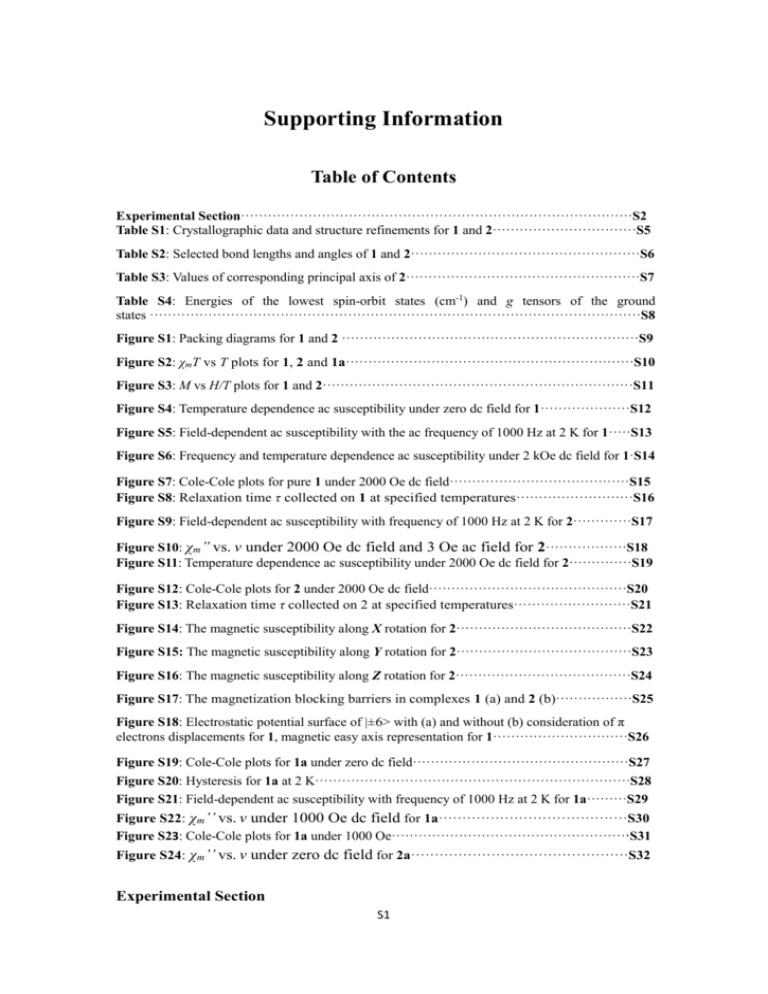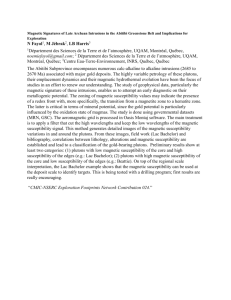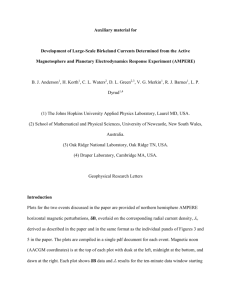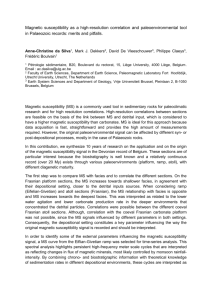chem201600023-sup-0001-SupMat
advertisement

Supporting Information Table of Contents Experimental Section·······················································································S2 Table S1: Crystallographic data and structure refinements for 1 and 2································S5 Table S2: Selected bond lengths and angles of 1 and 2···················································S6 Table S3: Values of corresponding principal axis of 2····················································S7 Table S4: Energies of the lowest spin-orbit states (cm-1) and g tensors of the ground states ·············································································································S8 Figure S1: Packing diagrams for 1 and 2 ··································································S9 Figure S2: χmT vs T plots for 1, 2 and 1a································································S10 Figure S3: M vs H/T plots for 1 and 2·····································································S11 Figure S4: Temperature dependence ac susceptibility under zero dc field for 1····················S12 Figure S5: Field-dependent ac susceptibility with the ac frequency of 1000 Hz at 2 K for 1·····S13 Figure S6: Frequency and temperature dependence ac susceptibility under 2 kOe dc field for 1·S14 Figure S7: Cole-Cole plots for pure 1 under 2000 Oe dc field········································S15 Figure S8: Relaxation time τ collected on 1 at specified temperatures··························S16 Figure S9: Field-dependent ac susceptibility with frequency of 1000 Hz at 2 K for 2·············S17 Figure S10: χm’’ vs. v under 2000 Oe dc field and 3 Oe ac field for 2··················S18 Figure S11: Temperature dependence ac susceptibility under 2000 Oe dc field for 2··············S19 Figure S12: Cole-Cole plots for 2 under 2000 Oe dc field············································S20 Figure S13: Relaxation time τ collected on 2 at specified temperatures··························S21 Figure S14: The magnetic susceptibility along X rotation for 2·······································S22 Figure S15: The magnetic susceptibility along Y rotation for 2·······································S23 Figure S16: The magnetic susceptibility along Z rotation for 2·······································S24 Figure S17: The magnetization blocking barriers in complexes 1 (a) and 2 (b)·················S25 Figure S18: Electrostatic potential surface of |±6> with (a) and without (b) consideration of π electrons displacements for 1, magnetic easy axis representation for 1······························S26 Figure S19: Cole-Cole plots for 1a under zero dc field················································S27 Figure S20: Hysteresis for 1a at 2 K······································································S28 Figure S21: Field-dependent ac susceptibility with frequency of 1000 Hz at 2 K for 1a·········S29 Figure S22: χm’’ vs. v under 1000 Oe dc field for 1a········································S30 Figure S23: Cole-Cole plots for 1a under 1000 Oe·····················································S31 Figure S24: χm’’ vs. v under zero dc field for 2a··············································S32 Experimental Section S1 The synthesis of air and/or moisture sensitive compounds was carried out under an atmosphere of argon using Schlenk techniques or in a Argon filled glovebox. THF was dried in solvent purification system, transferred under vacuum, and stored in the glovebox. Cyclooctatetraene (COT) was degassed after dried over activated 4 Å molecular sieves overnight. [(COT)LnCl(THF)](Ln = Tm, Y) were prepared according to literature procedures.1 Unless otherwise noted, all starting materials were commercially available and were used without further purification. Elemental analysis was performed by Elementar Vario MICRO CUBE (Germany). The ICP analysis was performed by Inductively Coupled Plasma-Atomic Emission Spectrometer designed by Leeman company. [(Tp)Tm(COT)] 1: A THF solution (10 mL) of TpK (168.9 mg, 0.70 mmol) was slowly added to the slurry of [(COT)TmCl(THF)] (250 mg, 0.67 mmol) in THF and stirred overnight. The solution was filtered and concentrated to 3 mL, and left unperturbed to allow the slow evaporation of the solvent. Yellow single crystals were obtained suitable for X-ray diffraction analysis after several days. Yield: 124 mg. Anal. Calcd (%) for C17H18BN6Tm: C, 42.00; H, 3.73; N, 17.28. Found: C, 42.06; H, 3.91; N, 17.55. [(Tp*)Tm(COT)] 2: Following the procedure described for 1. The reaction of [(COT)TmCl(THF)] (250 mg, 0.67 mmol) with Tp*K (225 mg, 0.69 mmol) gave orange-red crystals. Yield: 76 mg. Anal. Calcd (%) for C23H30BN6Tm: C, 48.44; H, 5.30; N, 14.73. Found: C, 48.13; H, 5.33; N, 14.59. [(Tp)Tm0.05Y0.95(COT)] 1a: The [(COT)TmCl(THF)] and [(COT)YCl(THF)] were mixed in 5:95 molar ratio, and followed by the same procedure of 1. Light yellow crystal was obtained for X-ray diffraction analysis. The space group is P212121. The Unit cell dimension is a=7.3481(2) Å, b=13.1972(4) Å, c=18.3906(5) Å, V=1783.42(9) Å3. The final ratio is determined by both the dc susceptibility measurement and ICP. The magnetic experiment gives the molar ratio of 5.6 : 94.4, which is accordance with the original ratio. The amount of TmIII (5.5 %) is also confirmed by the ICP analysis. S2 [(Tp*)Tm0.05Y0.95(COT)] 2a: Follow the method of 1a. light red crystal was obtained for X-ray diffraction analysis. The space group is P1. The Unit cell dimension is a= 10.2863(2) Å, b= 10.4698(2) Å, c= 12.6171(3) Å, α= 100.0961(18), β= 105.5608(19) γ = 112.539(2)V= 1143.96(4) Å3. The amount of TmIII (4.3 %) is found by the ICP analysis. X-ray crystallography and magnetic measurement All crystals were manipulated under a nitrogen atmosphere and were covered in grease. Data collections were performed at 180 K on a Aglient technologies Super Nova Atlas Dual System, with a (Mo Kα= 0.71073 Å) microfocus source and focusing multilayer mirror optics. The structures were solved by direct methods and refined with the full-matrix least-squares technique based on F2 using the SHELXL program. All non-hydrogen atoms were refined anisotropically. Hydrogen atom on B atom was located from the difference Fourier maps. Other hydrogen atoms were placed at the calculation positions. Samples were fixed by eicosane to avoid moving during measurement and sealed in the glass tube to avoid reaction with moisture and oxygen. Direct current susceptibility experiment was performed on Quantum Design MPMS XL-5 SQUID magnetometer on polycrystalline sample. Alternative current susceptibility measurement with frequencies ranging from 100 to 10000 Hz was performed on Quantum Design PPMS and ranging from 1 to 1000 Hz was performed on Quantum Design MPMS-XL5 SQUID magnetometer on polycrystalline sample. All dc susceptibilities were corrected for diamagnetic contribution from the sample holder, eicosane and diamagnetic contributions from the molecule using the pascal’s constants. Angular-resolved magnetometry measurement was performed using Quantum Design horizontal rotator. The faces of suitable single crystal of 2 were indexed on a Aglient technologies Super Nova Atlas Dual System. The experimental Cartesian coordinates XYZ were defined as below. We define the crystallographic b axis parallel to X axis, and the normal of (101) face parallel to Z axis. The S3 crystal was fixed using N grease on the plate of the rotator. Then we performed the rotation measurement along defined XYZ axes under applied 0.2 T dc field. As the mass of the sample can be obtained with required accuracy, we compared the mass from balance and the density product volume. All data were corrected for the diamagnetic contribution from the grease and rotator. Ab initio calculations Complete-active-space self-consistent field (CASSCF) calculations on the complete structures of complexes 1 and 2 on the basis of X-ray determined geometry have been carried out with MOLCAS 7.8 program package. For CASSCF calculations, the basis sets for all atoms are atomic natural orbitals from the MOLCAS ANO-RCC library: ANO-RCC-VTZP for TmIII ion; VTZ for close C and N; VDZ for distant atoms. The calculations employed the second order Douglas-Kroll-Hess Hamiltonian, where scalar relativistic contractions were taken into account in the basis set and the spin-orbit coupling was handled separately in the restricted active space state interaction (RASSI-SO) procedure. The active electrons in 7 active spaces included all f electrons (CAS(12 in 7)) in the CASSCF calculation. To exclude all the doubts we calculated all the roots in the active space. We have mixed all of the possible spin-free states (all from 21 triplets; all from 28 singlets). References 1) H. Schumann, R. D. Koehn, F. W. Reier, A. Dietrich and J. Pickardt, Organometallics, 1989, 8, 1388. S4 Table S1 Crystallographic data and structure refinements for 1 and 2. formula 1 2 Mr cryst syst space group a, Å b, Å c, Å V, Å3 α, deg β, deg γ, deg Z T, K μ, mm−1 λ, Å Cryst size, mm3 GOF Rint R1, wR2[I >2σ(I)] R1, wR2[all data] 486.11 orthorhombic P 212121 7.3442(1) 13.1951(3) 18.2376(4) 1767.36(6) 90 90 90 4 180(2) 5.031 0.71073 0.30*0.30*0.15 1.063 0.0626 0.0366, 0.0871 0.0432, 0.0920 570.27 triclinic P1 10.2525(3) 10.4225(3) 12.6063(4) 1138.94(6) 99.828(3) 105.686(3) 112.582(3) 2 180(2) 3.917 0.71073 0.20*0.20*0.10 1.079 0.0459 0.0251, 0.0511 0.0311, 0.0544 S5 Table S2 Selected bond lengths and angles of 1 and 2. 1 2 Tm–N(1), Å 2.386(4) 2.493(2) Tm–N(2), Å 2.380(5) 2.442(3) Tm–N(3), Å 2.390(5) 2.485(3) Tm–C(COT), Å 2.54(1)~2.55(1) 2.544(7)~2.602(9) Tm–centroid of COT, Å 1.7592(2) 1.7969(1) Tm–centroid of N(1, 2, 3) 1.6222(2) 1.6496 ∠N(1)-Tm-N(2) 79.8(1)° 76.8(1)° ∠N(2)-Tm-N(3) 77.5(1)° 75.9(1)° ∠N(3)-Tm-N(1) 79.2(1)° 88.3(1)° ∠B-Tm-centroid of COT 179.1(9)° 173.265(2)° S6 Table S3 Values of corresponding principal axis of 2. T/K χzz χxx χyy 1.9 2 2.5 3 3.5 4 4.5 5 6 7 8 9 10 11 13 15 20 7.42422 7.05425 5.80495 4.90634 4.22916 3.70433 3.31803 2.99038 2.50375 2.15645 1.89577 1.68207 1.51857 1.38058 1.16743 1.01124 0.75589 0.19432 0.20297 0.14223 0.11366 0.09807 0.0871 0.08191 0.08495 0.06352 0.05354 0.04924 0.04433 0.04094 0.03996 0.03488 0.03049 0.02418 0.09876 0.09929 0.07507 0.05799 0.0535 0.04592 0.03911 0.05774 0.0317 0.03148 0.02794 0.02619 0.0243 0.02174 0.01944 0.01837 0.01567 S7 Table S4 Energies of the lowest spin-orbit states (cm-1) and g tensors of the ground states 1 2 Energies of the lowest spin-orbit states (cm-1) 1 0 0 2 0.012 0.023 3 394.736 406.519 4 414.117 409.444 5 430.085 477.967 6 448.022 493.356 7 456.837 538.069 8 508.773 566.838 9 519.278 590.420 10 541.641 605.767 11 589.816 623.524 12 601.413 647.466 13 604.540 654.709 g tensor of the ground state gx 0.000 0.000 gy 0.000 0.000 gz 13.964 13.959 S8 (a) (b) Figure S1 Packing diagram for 1 and 2 shown along the crystallographic a axis. Color code: grey, carbon; blue, nitrogen; yellow, boron; pink, thulium. H atoms have been omitted for clarity. S9 Figure S2 Temperature dependence of the dc magnetic susceptibility times temperature for 1 and 2 under 1000 Oe applied dc magnetic field. Inset: χmT vs T plots for 1 and 1a. S10 (a) (b) Figure S3 M vs H/T plots for 1 (a) and 2 (b). S11 Figure S4 Temperature dependence ac susceptibility under zero dc field for 1. S12 Figure S5 Field-dependent ac susceptibility with the ac frequency of 1000 Hz at 2 K for 1. S13 a) b) Figure S6 a) Frequency-dependent ac susceptibility under 2 kOe dc field for 1 collected on MPMS-XL5 from 1 Hz to 1000 Hz; b) Temperature-dependent ac susceptibility under 2 kOe dc field for 1 collected on PPMS from 100 Hz to 10000 Hz. S14 a) b) Figure S7 a) Cole-Cole plots fit for the determination of the temperature dependence of τ for pure 1 under 2000 Oe dc field on MPMS-XL5 from 4 K to 17 K; b) Cole-Cole plots fit for the determination of the temperature dependence of τ for pure 1 under 2000 Oe dc field on PPMS from 7 K to 30 K. Solid lines represent the results of fitting to a generalized Debye model. S15 Figure S8 Relaxation time τ collected on 1 at specified temperatures under different dc fields from 0 to 2000 Oe. S16 Figure S9 Field-dependent ac susceptibility with frequency of 1000 Hz at 2 K for 2. S17 a) b) Figure S10 a) Out-of-phase (χm’’) signal vs. frequency (v) plots under 2000 Oe dc field and 3 Oe ac field on MPMS-XL5 for 2; b) Out-of-phase (χm’’) signal vs. frequency (v) plots under 2000 Oe dc field and 3 Oe ac field on PPMS for 2. S18 Figure S11 Temperature dependence ac susceptibility under 2000 Oe dc field for 2. S19 a) b) Figure S12 a) Cole-Cole plots fit for the determination of the temperature dependence of τ for 2 under 2000 Oe dc field from 2 K to 11 K on MPMS-XL5; b) Cole-Cole plots fit for the determination of the temperature dependence of τ for 2 under 2000 Oe dc field from 5 K to 20 K on PPMS. Solid lines represent the results of fitting to a generalized Debye model. S20 Figure S13 Relaxation time τ collected on 2 at specified temperatures under applied dc fields from 0 to 5000 Oe. S21 Figure S14 The magnetic susceptibility along X rotation for 2. S22 Figure S15 The magnetic susceptibility along Y rotation for 2. S23 Figure S16 The magnetic susceptibility along Z rotation 2. S24 Figure S17 The magnetization blocking barriers in complexes 1 (a) and 2 (b). The thick black lines represent the non-Kramers doublets as a function of their magnetic moment along the magnetic axis. The green lines correspond to diagonal quantum tunneling of magnetization (QTM); the blue line represents Orbach relaxation process. The numbers at each arrow stand for the mean absolute value of the corresponding matrix element of transition magnetic moment. The path shown by the red arrows represents the most probable path for magnetic relaxation in the corresponding compounds. S25 Figure S18 Electrostatic potential surface of |±6> with (a) and without (b) consideration of π electrons displacements for 1. Magnetic easy axis orientations (c) determined by CASSCF calculations (green) and the electrostatic model (blue), respectively. S26 Figure S19 Cole-Cole plots fit for the determination of the temperature dependence of τ for 1a under zero dc field from 2 K to 16 K. Solid lines represent the results of fitting to a generalized Debye model. S27 Figure. S20 Hysteresis experiment under the field scanning rate of 1.9 mT/s for 1a. S28 Figure. S21 Field-dependent ac susceptibility with frequency of 1000 Hz at 2 K for 1a. S29 Figure S22 Out-of-phase (χm’’) signal vs. frequency (v) plots under 1000 Oe dc field and 3 Oe ac field for 1a from 7 K to 27 K. S30 Figure S23 Cole-Cole plots fit for the determination of the temperature dependence of τ for 1a under 1000 Oe from 10 K to 27 K. Solid lines represent the results of fitting to a generalized Debye model. S31 Figure S24 Out-of-phase (χm’’) signal vs. frequency (v) plots under zero dc field and 3 Oe ac field for magnetic diluted 2(2a) from 2 K to 22 K. S32







